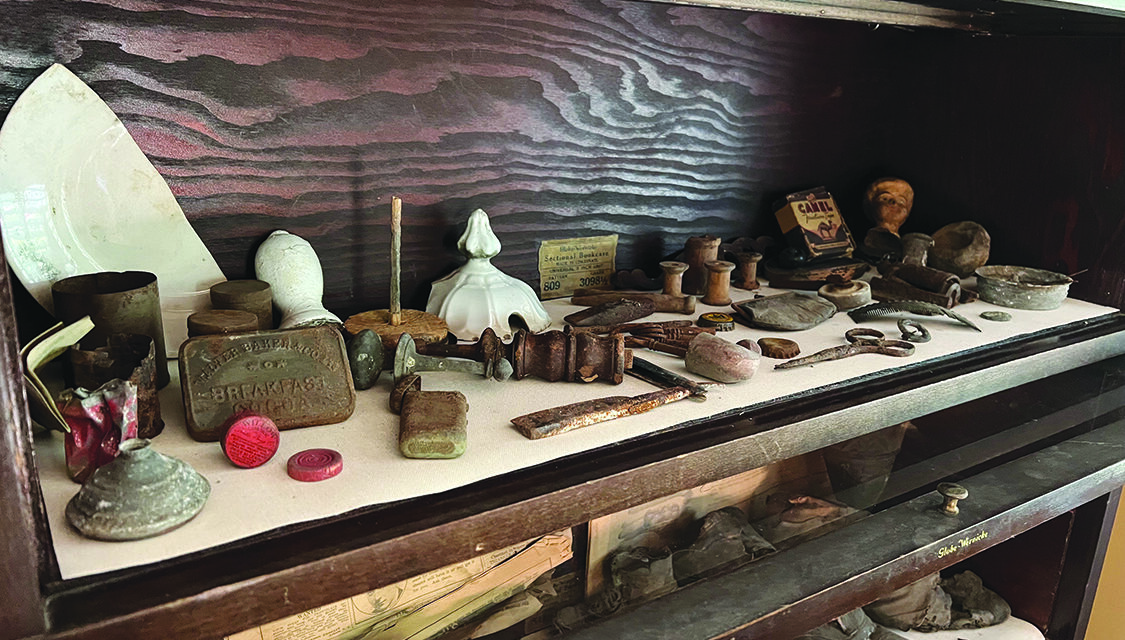(This article is part of a series that spotlights historic farmhouses in Caroline, Dorchester, Queen Anne’s, Kent and Talbot counties. These homes are being given new life by the younger generation that lives in them presently.)

Molly Reid’s house, above, as it appears today, freshly painted and with a repositioned front door. (Photo courtesy Molly Reid)
Eighteen years ago Molly Reid was living in Federal Hill when a hit television show chronicling the crime in Baltimore began filming on her street. That was the final push she needed to realize she needed to move.
The question, though, was where? Her parents had bought a historic home in Trappe, and Reid loved the feel of the little town adjacent to route 50.
One of the first houses she looked at was the one she ended up buying — the Jenkins House on Main Street.
Built in 1853, it started as a shop owned by the Jenkins family and then was passed down to their daughter and her husband, Rachel and William Bowdle. The Mullikin Family owned it for awhile, and it eventually was purchased by Ed Cannon. He was a WWII veteran who lost his wife to cancer, and spent the rest of his life as a widower. He lived in the home for 60 years and worked at Murdoch’s Gardens before passing away, leaving the house full of his belongings and the plants he had lovingly planted blooming in the yard.
Intrigued as she was, Reid said she didn’t feel comfortable purchasing it. It was more or less a time capsule in dire need of repair and renovation. Another buyer came along and began doing some work on the house, including removing the back staircase to expand the kitchen. A second opportunity arose for Reid to purchase the house and this time she could not resist.
Almost immediately she began remodeling the house with the help of her family. The list of things that needed to be done seemed endless.
The house had been heated with a kerosene heater in the kitchen and the wiring was knob-and-tube. While the plumbing and electrical work was being done there was no running water and only one functioning outlet. That winter she slept in her coat, hat, and gloves.
Reid joked that for awhile she only ate things that started with P, such as popcorn, peanut butter, and Pringles.
“The market was so hot in 2005 that I couldn’t get contractors quickly, I had to wait until they had time to come do the work,” she said.
A chute was built to go out the window in order to expedite the removal of all the horsehair plaster, rotten wood and bricks. Things moved slowly, but eventually they began to take shape.
Baseboard heating and mini-split units now make the house comfortable to live in. Wide plank floors were laid in the living room and secured with hand-forged nails from a blacksmith in Pennsylvania. The kitchen was updated with granite countertops and enlarged door frames that would accommodate the delivery of new appliances. A window was added over the sink to add natural light. The beams in her bedroom and office upstairs were exposed, the ceilings raised in order to create more open spaces.
The chimney and fireplace in the center of the house, unsturdy from years of neglect, were removed.
The front door was shifted from its location directly at the bottom of the front staircase to perpendicular to it, creating a more functional and spacious entryway.
While they worked, they found creative ways to repurpose the materials.
Studs that were removed or replaced were crafted into a kitchen island, a dog door connecting the kitchen to the back sunporch and a mirror frame that hangs upstairs.
“Any bricks that made it out the window in one piece were used to build the front porch foundation, back door step and patio,” Reid said.
Perhaps the most fascinating part of the remodel were the treasures that were uncovered: a Seagull Baking Soda bottle, a comb, cigarette packages, a lighter, a straight razor, a doll, bottlecaps, an inkwell, a bottle from the Kemp Druggist Shop in Trappe. So many pieces of history that laid in wait for someone to find them.
Also worth noting are the pairs of shoes that were found inside one of the walls: a man’s slipper, a pair of children’s shoes, a pair of ladies’ Victorian boots with tiny buttons.
Reid explained that during Victorian times it was considered good luck to put shoes in the wall of a home that was being built and in keeping with that tradition she put a pair of her own shoes in the wall when they were remodeling.
Many of the furniture pieces were passed down from Reid’s beloved family members, such as the beautiful secretary desk in her study and the bookcase upstairs.
Her mother is a talented artist and her paintings are featured in many of the rooms.
This summer Griffin and Sons Contracting carefully removed the shingle siding, restored the handcut pine that was beneath it and painted it Rose Brocade, a shade carefully chosen by Reid. It took three coats and required 129 gallons of paint.
Like any other homeowner, Reid still has many projects in the works. The fireplace in her study she hopes to convert to a pellet stove for ambiance and supplemental heat. Shelves under the staircase will provide extra storage and a place to display photos and books.
When asked what she loves most about living in her historic home, Reid’s answer came easily. “I love its character. It’s not ‘cookie cutter,’ it’s one of a kind.”




